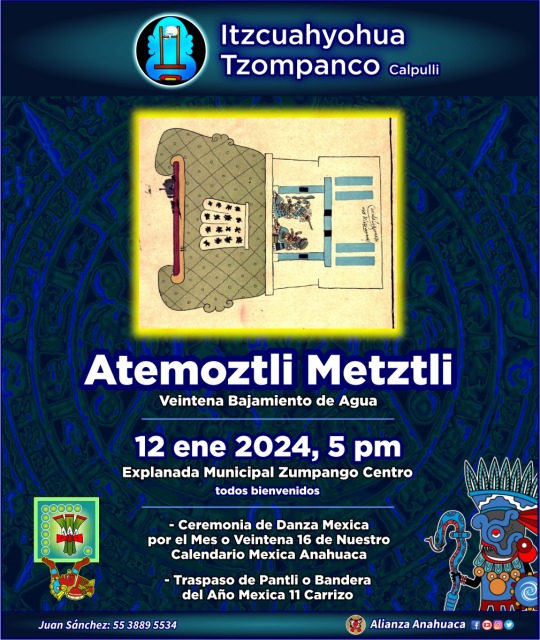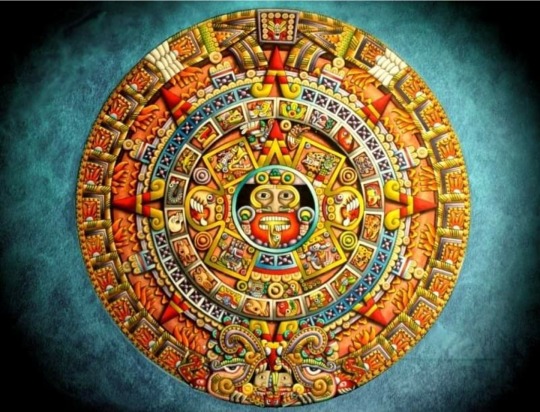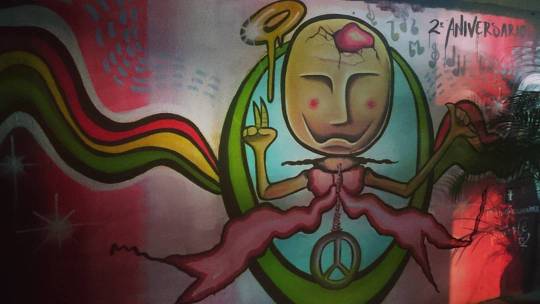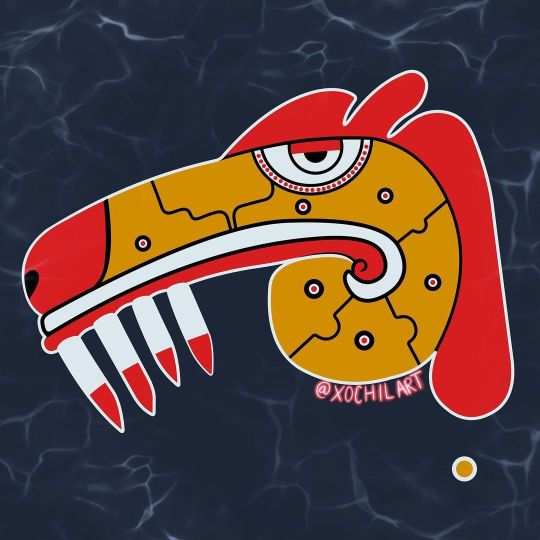#atemoztli
Explore tagged Tumblr posts
Text
Ceremonia de Danza Mexica Anahuaca por Veintena Bajamiento de Agua, ATEMOZTLI. 2024
Ceremonia de Danza Mexica Anahuaca por Veintena Bajamiento de Agua, ATEMOZTLI12 ene 2024, 5 pm. Explanada Municipal Zumpango Centro EdomexItzcuahyohua Tzompanco Calpulli Todos invitados y bienvenidoshttps://www.facebook.com/AlianzaAnahuaca

View On WordPress
1 note
·
View note
Text

La próxima vez que un mamerto se queje de la conquista de los españoles y el cristianismo cuéntale que los aztecas tenían 18 festividades cada año, una por cada mes azteca. Aquí la lista de los meses y el tipo de ritual que se celebraba en honor a la deidad asociada.
- 1º mes Atlacahualo en honor a Tláloc
⇨ Sacrificio de niños y cautivos a las deidades del agua
- 2º mes Tlacaxipehualiztli en honor a Xipe Tótec
⇨ Sacrificio de los cautivos; luchadores de gladiadores; bailes del sacerdote vistiendo la piel de las víctimas desolladas
- 3º mes Tozoztontli en honor a Coatlicue
⇨ Extracción del corazón de cautivos; enterramiento de las pieles humanas desolladas; sacrificios de niños
- 4º mes Huey tozoztli en honor a Centéotl
⇨ Sacrificio de una virgen; también de un niño y una niña
- 5º mes Toxcatl en honor a Tezcatlipoca,
⇨ Sacrificio de cautivos por extracción del corazón.
- 6º mes Etzalcualiztli en honor a Tlaloque
⇨ Sacrificio por ahogamiento y extracción del corazón
- 7º mes Tecuilhuitontli en honor a Huixtocihuatl
⇨ Sacrificio por extracción del corazón.
- 8º mes Huey Tecuilhuitl en honor a Xilonen
⇨ Sacrificio de una mujer decapitada y extracción de su corazón.
- 9º mes Tlaxochimaco en honor a Huitzilopochtli
⇨ Sacrificio por inanición en una cueva o templo
- 10º mes Xocohuetz en honor Xiuhtecuhtli
⇨ Presentes a los dioses del fuego quemando a las víctimas.
- 11º mes Ochpaniztli en honor a Toci
⇨ Sacrificio de una joven decapitada a Toci; ella era desollada y un joven vestía su piel; sacrificio de cautivos arrojándoles de un lugar alto y extracción del corazón.
- 12º mes Teotleco en honor a Tezcatlipoca
⇨ Sacrificios por fuego; extracción del corazón
- 13º mes Tepeilhuit en honor a Tláloc
⇨ Sacrificios de niños, dos mujeres nobles, extracción del corazón y desollamiento; canibalismo ritual
- 14º mes Quecholli en honor a Mixcóatl
⇨ Sacrificio por aplastamiento, decapitación y extracción del corazón.
- 15º mes Panquetzaliztli en honor a Huitzilopochtli, deidad de la guerra, el sol, el sacrificio humano y el patrón de la ciudad de Tenochtitlan (el más importante de todos los dioses)
⇨ Masivos sacrificios de cautivos y esclavos por extracción del corazón.
- 16º mes Atemoztli en honor a Tláloc
⇨ Sacrificios de niños y esclavos por decapitación.
- 17º mes Tititl en honor a Ilamatecuhtli
⇨ Sacrificio de una mujer por extracción del corazón y decapitación posterior.
- 18º mes Izcalli en honor a Xiuhtecuhtli
⇨ Sacrificios de víctimas que representan a Xiuhtecuhtli y sus mujeres (cada una de 4 años de edad!!!) y sus cautivos
En fin, cada año, los aztecas sacrifican un promedio de 20,000 personas, desde hombres adultos a niños recién nacidos, de diversas y tortuosas maneras. En ocasiones especiales, los "dioses" exigían incluso más sangre de lo habitual. Por ejemplo, cuando se dedicó un nuevo templo a Huitzilopochtli en 1487 (32 años antes que Cortés arribara a la costa mexicana), se estima que 80,000 personas fueron sacrificadas.
===
– Imagen:
El Códice Magliabecchiano, folio 73r, una escena que representa el canibalismo azteca ritualista, una práctica común después de los sacrificios. De hecho, el típico plato mexicano "pozole", antes de la llegada de los Españoles, era preparado con carne humana de los sacrificados. Fue gracias a la influencia Cristiana Española, que el pozole ahora se prepara con carne de cerdo. El códice fue creado durante el siglo XVI en el periodo colonial temprano y muestra los nombres de los 20 días del tonalpohualli, calendario religioso de 18 meses que forma parte del ciclo de 52 años mexica.
10 notes
·
View notes
Photo

Saturday from 6pm to Sunday at 6pm was day 12 in the 13 day cycle, it was 11Malinalli or herb #malinalli is number 12 in the 20 day cycle. the 13 day cycle is ze #ehacatl the wind. . 20 day cycle is #atemoztli the resending waters . Year 8 #Tecpatl the flint our tongue or words pointed and sharp. . Malinalli is considered the most mysterious of the signs #cemanahuac #astrology #energywork #mexicanastrology #Nahuatl #aztec #Cemanahuac #tonalmachiotl #decolonize #decolonizeastrology #mesoamerica #mexica #starseed #eaglenation #native #ometeotl #art #nativeart #xochipillivisions #indiginousart #mexicanartist #chicano #nawatl #mesoamericanart #herb #astrology #skull https://www.instagram.com/p/CKLO9OUAH7L/?igshid=qbfw7eb61zu0
#malinalli#ehacatl#atemoztli#tecpatl#cemanahuac#astrology#energywork#mexicanastrology#nahuatl#aztec#tonalmachiotl#decolonize#decolonizeastrology#mesoamerica#mexica#starseed#eaglenation#native#ometeotl#art#nativeart#xochipillivisions#indiginousart#mexicanartist#chicano#nawatl#mesoamericanart#herb#skull
0 notes
Text
AU: Undermictlán
By: Fast08
.
.
.
.

Mictlán!Toriel would have the same personality as the original Toriel, however, she would be more overprotective with Frisk when she found out about his fear and phobia so if the boy wanted to leave the house to walk through the ruins, Toriel would accompany him to ask him feel more secure. When Frisk turned 8 years old, Toriel noticed that he was not as fearful as in his first days in the underground apart from the fact that he had become a little more independent, despite that and that he has managed to overcome his fears, Toriel asks him to be keep next to Napstablook in case a problem arises unexpectedly.
As you may have noticed, Mictlán!Toriel is a skeleton goat. Cause? Let's say that the flesh and blood monsters had to "adapt to the environment" of the underground.
-_-_-_-_-_-_-_-_-_-_-_-_-_-_-_-_-_-_-_-_-_-_-_-_
Mictlán!Toriel tendría la misma personalidad que la Toriel original, sin embargo, ella sería más sobreprotectora con Frisk al enterarse sobre su miedo y fobia por lo que si el niño quisiera salir de la casa para pasear por las ruinas, Toriel lo acompañaría para hacerle sentir más seguro. Cuando Frisk cumplió 8 años, Toriel notó que este no era tan temeroso como en sus primeros días en el subsuelo aparte de que este se había vuelto un poco más independiente, pese a eso y que haya logrado superar sus miedos, Toriel le pide que se mantenga al lado de Napstablook por si algún problema surgía inesperadamente.
Como ya habrán podido notar, Mictlán!Toriel es una cabra esqueleto. ¿Causa? Digamos que los monstruos de carne y hueso tuvieron que "adaptarse al ambiente" del subsuelo.
.
.
.
.
.

(I think it shows that I did not put much effort into Froggit, Moldsmal and Migosp xd)
Mictlán!Napstablook:
"Ozholli" literally means "Ruins" in Nahuatl, and in turn "Atemoztli" literally means "Waterfall" (obviously Ozholli are the Ruins and Atemoztli is the Waterfall of my AU).
Mictlán!Napstablook, preferring solitude, adapted its color, it is orange when it is in Ohzolli since this way it can be camouflaged with the marigold petals found on the ground. The same thing happens when he is in Atemoztli, he takes bluish tones to go unnoticed. What if it is not in either of those two places? It would have its original color (like the original Napstablook). The "Mariachili blook" thing is something from the prologue of the Undermictlán story, Mariachili is the combination of "mariachi" and "chili". Why this? It is that I felt that the appearance of Napstablook in the ruins made it look like a chili, to be more exact, a habanero chili xd
Mictlán!Froggit:
There is not much to clarify, it is simply a skeleton like the rest of the monsters that were previously made of flesh and blood.
Mictlán!Whimsun & Mictlán!Dummy:
Both represent the alebrijes, the alebrije is a type of Mexican handicraft made of cardboard or paper, and a wire or wood structure (traditionally made of copal), which are painted with mostly cheerful and vibrant colors. I know that Dummy is just a puppet (his name gives it away) but he represents what an authentic alebrije is because of its colors and what it is: a craft.
Mictlán!Vegetoid:
Represents the chile en nogada which is one of the typical dishes of the gastronomy of the state of Puebla, it is known as "the Mexican dish par excellence". The base of the dish is poblano chili, which is stuffed with pork and / or beef mixed with panochera apple, milk pear and Creole peach, which are characterized by being smaller and a little more acidic. In addition, you can add nuts, such as pine nuts, almonds and raisins.
Mictlán!Loox:
The typical sweet skull (also known as the alfeñique skull), is a typical treat of the Day of the Dead/Día de muertos in Mexico made of sugar, chocolate, amaranth or some other raw material.
Mictlán!Moldsmal:
It is a mosaic jelly, it is unknown if its origin is Mexican or Brazilian but it is a very famous dessert in Mexico.
Mictlán!Migosp:
Represents or rather is the intent of a wrestler, I put intent since the suit is not as flashy as they usually tend to be.
-_-_-_-_-_-_-_-_-_-_-_-_-_-_-_-_-_-_-_-_-_-_-_-_
(Creo que se nota que no les puse mucho empeño a Froggit, Moldsmal y Migosp xd)
Mictlán!Napstablook:
"Ozholli" literalmente significa "Ruinas" en nahuatl, y a su vez que "Atemoztli" significa literalmente "Cascada" (obviamente Ozholli son las Ruinas y Atemoztli es el Waterfall de mi AU).
Mictlán!Napstablook al preferir la soledad adaptó su color, es de tonos anaranjados cuando está en Ohzolli ya que así puede camuflarse con los pétalos de cempasúchil que se encuentran en el suelo. Pasa lo mismo cuando se encuentra en Atemoztli, toma tonos azulados para pasar desapercibido. ¿Y si no se encuentra en ninguno de esos dos lugares? Tendría su color original (osease como el Napstablook original). Lo de "Mariachili blook" es algo del prólogo de la historia de Undermictlán, Mariachili es la combinación de "mariachi" y "chili" ¿por qué esto? Es que sentí que la apariencia de Napstablook en las ruinas lo hacía ver como un chile, para ser más exactos, un chile habanero xd
Mictlán!Froggit:
No hay mucho que aclarar, simplemente es un esqueleto al igual que el resto de los monstruos que anteriormente eran de carne y hueso.
Mictlán!Whimsun y Mictlán!Dummy:
Ambos representan a los alebrijes, el alebrije es un tipo de artesanía mexicana hecha de cartón o papel, y estructura de alambre o con madera (tradicionalmente de copal), que se pintan con colores mayormente alegres y vibrantes. Sé que Dummy es solo una marioneta (su nombre lo delata) pero representa lo que es un auténtico alebrije por sus colores y por lo que es este: una artesanía.
Mictlán!Vegetoid:
Representa al chile en nogada el cual es uno de los platillos típicos de la gastronomía del estado de Puebla, se le conoce como "el platillo mexicano por excelencia". La base del platillo es el chile poblano, que se rellena con carne de puerco y/o res mezclada con manzana panochera, pera lechera y durazno criollo, que se caracterizan por ser más pequeñas y un poco más ácidas. Además, se pueden agregar frutos secos, como piñón, almendras y pasas.
Mictlán!Loox:
La típica calaverita de dulce (también conocida como calavera de alfeñique), es una golosina típica del Día de Muertos en México hecho de azúcar, chocolate, amaranto o alguna otra materia prima.
Mictlán!Moldsmal:
Es una gelatina de mosaico, se desconoce si su origen es mexicano o brasileño pero es un postre muy famoso en México.
Mictlán!Migosp:
Representa o más bien es el intento de un luchador de lucha libre, pongo intento ya que el traje no es tan llamativo como normalmente suelen ser.
3 notes
·
View notes
Text

¿Sabías que La piedra del sol NO es un calendario?
(Primera parte)
El verdadero calendario azteca funciona de la siguiente manera:
La cuenta de los días
En la cultura nahua los días se cuentan por veintenas, llamadas cempoallapohualli «la cuenta de las veintenas». Cada uno de estos 20 días tiene un nombre, asociado a una deidad.
Nombre del día
1. Cipactli, «caimán o lagarto».
2. Ehécatl, «viento o aire».
3. Cali, «casa u hogar».
4. Cuetzpalin, «lagartija».
5. Cóatl, «serpiente».
6. Miquiztli, «muerte o calavera».
7. Mázatl, «venado».
8. Tochtli, «conejo».
9. Atl, «agua».
10. Itzcuintli, «perro».
11. Ozomatli, «mono».
12. Malinali, «hierba muerta».
13. Ácatl, «caña o flecha».
14. Océlotl, «ocelote o jaguar».
15. Cuauhtli, «águila».
16. Cozcacuauhtli, «buitre».
17. Olin, «movimiento».
18. Técpatl, «cuchillo de pedernal».
19. Quiáhuitl, «lluvia».
20. Xóchitl, «flor».
Un año tiene 18 veintenas, las cuales tienen un nombre específico, algo parecido al calendario gregoriano de enero a diciembre.
1. Cuáhuitl Ehua
2. Tlacaxipehualiztli
3. Tozoztontli
4. Huey Tozoztli
5. Tóxcatl 14. Quecholli
6. Etzalcualiztli
7. Tecuilhuitontli
8. Huey Tecuílhuitl
9. Tlaxochimaco
10. Xócotl Huetzi
11. Ochpaniztli
12. Teotleco
13. Tepeílhuitl
15. Panquetzaliztli
16. Atemoztli
17. Títitl
18. Izcalli
18 meses de 20 días suman 360 días, más los 5 días llamados nemontemi «días aciagos» o «días en vano», porque no pertenecen a una divinidad y no cuentan en el ámbito religioso; sin embargo, sí se integran en la sucesión calendárica de los días para completar los 365 días del año.
Los años se cuentan de cuatro en cuatro, en el siguiente orden:
Ácatl «caña», Técpatl «Pedernal», Calli «Casa» y Tochtli «Conejo».
Cada uno de los 20 días se combina con 13 números.
El año Ácatl «caña» inicia con el mes 1 Cuáhuitl Ehua y el día «Uno Caimán», le siguen «Dos Viento», «Tres Casa», hasta llegar al «Trece Flecha».
El próximo signo «Jaguar» ya no lleva el número 14, sino que reinicia la numeración. Es decir que la segunda trecena empieza con el día «Uno Jaguar» y termina con «Trece Muerte», ubicándose en el segundo mes del año, el cual corresponde a Tlacaxipehualiztli, y así hasta que se llegue nuevamente al «Uno Caimán», con el cual reinicia la cuenta de los días, pero continúa la cuenta de los meses hasta que se llegue al mes 18 que corresponde a Izcalli.
Se cuentan los cinco días aciagos e inicia el año Técpatl «Pedernal», en el mes Cuáhuitl Ehua, día Dos Muerte. Y así sucesivamente.
El calendario completo estará en mi libro "Tlatoque III, Somos mexicas", disponible en librerías en el segundo semestre del 2021.

0 notes
Photo

Ishtarka - Atemoztli by ISHTARKA http://ift.tt/2nW2eEt
0 notes
Text
Representará Nuevo Laredo a zona norte en concurso de danza folclórica
Representará Nuevo Laredo a zona norte en concurso de danza folclórica
Nuevo Laredo, Tamaulipas.-Nuevo Laredo resultó ganador en la etapa regional del segundo concurso de danza folclórica, con lo que pasó a la etapa estatal que se realizará el próximo seis de diciembre en Ciudad Victoria. El grupo Atemoztli, conformado por maestras jubiladas, representan a Nuevo Laredo en la categoría Especial de este concurso realizado por el Sistema para el Desarrollo Integral de…
View On WordPress
0 notes
Text
Celebración y Ceremonia por Atemoztli, mes 16 del Calendario Mexicano. Nexcoalanco Iztaccihuatl
Celebración y Ceremonia por Atemoztli, mes 16 del Calendario Mexicano. Nexcoalanco Iztaccihuatl
Celebración y Ceremonia por Atemoztli, mes 16 del Calendario Mexicanodom 9 dic 2022, 7 a 19 hrs, Nexcoalanco Iztaccihuatl edomexColectivo Alianza Anahuaca Como cada veintena la Alianza Anahuaca realiza ofrendas a las energías del cosmos, en este mes corresponde a Tlaloc, Chalchiuhtlicue, Centeotl e Iztaccoliuhqui. Itinerario: Cita: 7am metro boulevard pto aéreo (partimos 7:15, bus…

View On WordPress
0 notes
Photo

Arte II #Atemoztli #PuertoEscondido (en Zicatela)
0 notes
Photo

Today at 6pm pst we start day 11 in the in the 13 day cycle, it is 10 Ozomatli or monkey. #ozomatli is number 11 in the tonalli . #iluikapotzintli or day companion is the power of photosynthesis, or #zenteotl which is harnessed from #xochipilli . #youalpotzintli or night companion is #mictlantecuhtli the lord of the underworld. . #totopotzintli or winged companion is #tecolotl the barn owl. the 13 day cycle is ze #ehacatl the wind. . 20 day cycle is #atemoztli the resending waters . Year 8 #Tecpatl the flint our tongue or words pointed and sharp. . #azomatli the monkey . The monkey represents our comprehension, and agility. The monkey is able to move about freely in all directions no matter the height or distance, the monkey is also the symbol of dance, happiness, and recreation When the sun is up this will be a great time to soak up the rays of the sun, dance! preferably near plants and flowers, take deep belly breaths, cry a river, grief , for yourself for others especially anyone who has transitioned/lost someone, dance because you are simply happy to be alive. Pray As you dance away ,and as your breath gets heavy Ehecatl will carry your prayers away. #cemanahuac #astrology #energywork #mexicanastrology #Nahuatl #aztec #Cemanahuac #tonalmachiotl #decolonize #decolonizeastrology #mesoamerica #mexica #starseed #eaglenation #native #ometeotl #nativeart #xochipillivisions https://www.instagram.com/p/CKFqC9ZARz6/?igshid=1m3ju2rfsfwjn
#ozomatli#iluikapotzintli#zenteotl#xochipilli#youalpotzintli#mictlantecuhtli#totopotzintli#tecolotl#ehacatl#atemoztli#tecpatl#azomatli#cemanahuac#astrology#energywork#mexicanastrology#nahuatl#aztec#tonalmachiotl#decolonize#decolonizeastrology#mesoamerica#mexica#starseed#eaglenation#native#ometeotl#nativeart#xochipillivisions
0 notes
Text
Atemoztli
Went to an Atemoztli ceremony yesterday and helped the mosaque , brought offerings of cornmeal since ididnt give yeztli. Felt to good to have helped with the altar. Tlazocamati calpulli teoxicalli tlazocamati a todos los tlamanalcas !! Tlazocamati tonantzin tlazocamati ometeotl tlazocamati quetzalcoatl tlazocamati tlaloc tlazocamati Chalchiuhtlicue.
1 note
·
View note
Photo

Yesterday at 6pm pst we started day 10 in the tonalli Day 10 is 9 #itzcuintli or dog i #iluikapotzintli or day companion is #mictlantecuhtli the guide of the place of transformation and rest, #youalpotzintli or night companion is #Coatlicue she with the jade skirt, #totopotzintli or winged companion is #chalchiuhtotolin the jade turkey eagle the 13 day cycle is ze #ehacatl the wind. 20 day cycle is #atemoztli the resending waters, Year 8 #Tecpatl the flint our tongue or words pointed and sharp. #itzkuintli or dog, the loyal companion of the two legged’s, it should come as no surprise they represent fidelity and loyalty the guide that can transform himself and their surroundings they love to travel but will never forget where they came from Today is a day to too rest so that your consciousness can be renewed before returning to activity. It is also a good day to transform , an transmute energies with all 3 guides of transformation present today. #cemanahuac #AMCS #astrology #energywork #mexicanastrology #Nahuatl #aztec #Cemanahuac #tonalmachiotl #decolonize #decolonizeastrology #mesoamerica #mexica #starseed #eaglenation #native #ometeotl #nativeart #transmutation #itzkuintli (at Mictlan) https://www.instagram.com/p/CKE-AOIglVq/?igshid=hym2z6g9fst1
#itzcuintli#iluikapotzintli#mictlantecuhtli#youalpotzintli#coatlicue#totopotzintli#chalchiuhtotolin#ehacatl#atemoztli#tecpatl#itzkuintli#cemanahuac#amcs#astrology#energywork#mexicanastrology#nahuatl#aztec#tonalmachiotl#decolonize#decolonizeastrology#mesoamerica#mexica#starseed#eaglenation#native#ometeotl#nativeart#transmutation
1 note
·
View note
Photo

It was my intention to start this a long time ago, but I kept missing the first day of the cycle and today as I was getting ready to go to bed my subconscious was like “its today” so I am just right on time! On 12-5-2021 At approx 6pm pst the new 20 day cycle began, the day will end today 1-6-2021 at 6pm and the 2nd day begins. It is #13Cipactli , #youalpotzintli is #coatlique . #iluikapotzintli is #xochipilli the 13 day cycle is #zealt the water. 20 day cycle is #atemoztli , Year 8 #Tecpatl #Cipactli is the first symbol in the #tonalli #1 the initiator Cipactli is the beginning, the spark, conception. #Zipactli swims in the unknown primordial waters. #tonalmachiotl #divinetime #ancientastrology #astrology #mexica #arteazteca #prehispanic #nicantlaca #alt #xochipillvisions #5thsun #ageofaquaarius #Indigenous #Indigenousastrology #8flint #tekpatl #alligator #crocodile https://www.instagram.com/p/CJsuhXnAg1W/?igshid=1eevhad2qy3dr
#13cipactli#youalpotzintli#coatlique#iluikapotzintli#xochipilli#zealt#atemoztli#tecpatl#cipactli#tonalli#1#zipactli#tonalmachiotl#divinetime#ancientastrology#astrology#mexica#arteazteca#prehispanic#nicantlaca#alt#xochipillvisions#5thsun#ageofaquaarius#indigenous#indigenousastrology#8flint#tekpatl#alligator#crocodile
0 notes
Photo

Yesterday at 6pm pst we started day 13 in the 13 day cycle, it is 13 #ozelotl or jaguar it is number 14 in the tonalli, this cycle will end at approximately 6pm today. . . #iluikapotzintli or day companion is #Tlazolteotl the regenerator, that transforms energy . . #youalpotzintli or night companion is #tepeyollotl or the heart of the mountain . . winged companion is #kochotl the parrot . . the 13 day cycle is ze ehacatl the wind. . . 20 day cycle is atemoztli the resending waters . Year 8 Tecpatl the flint our tongue or words pointed and sharp. . . # Ocelotl the Jaguar is a tenacious guide, the champion of just causes, and the guardian of the house of creating energy #kalli Its a good day for creativity, especially in the home, as in your body and your literal home , adorn your body, paint yourself , paint your house, do some moving around of furniture, clean up your space, make room for new energy to flow. #cemanahuac #astrology #energywork #mexicanastrology #Nahuatl #aztec #Cemanahuac #tonalmachiotl #decolonize #decolonizeastrology #mesoamerica #mexica #starseed #eaglenation #nativeamerican #ometeotl #nativeart #collectiveconsciousness #mesoamericanoccultism #jaguar #artwork #acrylicpainting https://www.instagram.com/p/CKPPx7Kg6rf/?igshid=1ons1n2wdjl2q
#ozelotl#iluikapotzintli#tlazolteotl#youalpotzintli#tepeyollotl#kochotl#kalli#cemanahuac#astrology#energywork#mexicanastrology#nahuatl#aztec#tonalmachiotl#decolonize#decolonizeastrology#mesoamerica#mexica#starseed#eaglenation#nativeamerican#ometeotl#nativeart#collectiveconsciousness#mesoamericanoccultism#jaguar#artwork#acrylicpainting
1 note
·
View note

